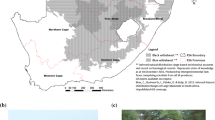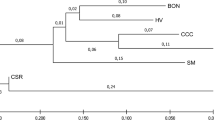Abstract
The red wolf (Canis rufus), native to much of the southeastern United States, is endangered by man's activities and by hybridization with other species of the genus Canis. The absence of diagnostic morphological markers to distinguish the red wolf from its hybrids has led to the application of the methods of biochemical genetics to this problem. The finding of a unique electrophoretically determined allele with a distribution congruent with the geographical distribution of the remaining red wolf population is reported.
Similar content being viewed by others
References
Baur, E. W., and Schorr, R. T. (1969). Genetic polymorphism of tetrazolium oxidase in dogs. Science 1661524.
Bengtsson, S., and Sandberg, K. (1973). A method for simultaneous electrophoresis of four horse red cell enzyme systems. Anim. Blood Grps. Biochem. Genet. 483.
Braend, M., and Austad, R. (1973). Polymorphism of red cell acid phosphatase in dogs. Anim. Blood Grps. Biochem. Genet. 4189.
Brewer, G. J. (1970). An Introduction to Isozyme Techniques Academic Press, New York.
Fisher, R. A., Putt, W., and Hackel, E. (1976). An investigation of the products of 53 gene loci in three species of wild Canidae: Canis lupus, Canis latrans and Canis familiaris. Biochem. Genet. 14963.
Hall, E. R., and Kelson, K. R. (1959). The Mammals of North America, Vol. II, Ronald Press, New York, p. 842.
Lawrence, B., and Bossert, W. H. (1967). Multiple character analysis of Canis lupus, latrans and familaris, with a discussion of the relationships of Canis niger. Am. Zool. 7223.
McCarley, H. (1959). The mammals of eastern Texas. Tex. J. Sci. 2385.
McCarley, H. (1962). The taxonomic status of wild canis (Canidae) in the south central United States. S.W. Naturalist 7227.
Meera Kahn, P., Los, W. R. T., Does, J. A., and Epstein, R. B. (1973). Isoenzyme markers in dog blood cells. Transplantation 15624.
Paradiso, J. L. (1965). Recent records of red wolves from the Gulf Coast of Texas. S.W. Naturalist 10318.
Paradiso, J. L. (1968). Canids recently collected in east Texas, with comments on the taxonomy of the red wolf. Am. Midland Naturalist 80529.
Paradiso, J. L., and Nowak, R. M. (1971). A Report on the Taxonomic Status and Distribution of the Red Wolf, U.S. Department of the Interior Special Scientific Report—Wildlife No. 145, Washington, D.C.
Pimlott, D. H., and Joslin, P. W. (1968). The status and distribution of the red wolf. In Tr. 33rd N.A. Wildlife Natural Resources Conf., p. 373.
Richkind, K. E., and Richkind, M. (1978). Polymorphism at the glucosephosphate isomerase locus in the dog. J. Hered. 69141.
Riley, G. A., and McBride, R. T. (1972). A Survey of the Red Wolf (Canis rufus), U.S. Department of the Interior Special Scientific Report—Wildlife No. 162, Washington, D.C.
Shaw, C. R., and Prasad, R. (1970). Starch gel electrophoresis of enzymes—A compilation of recipes. Biochem. Genet. 4297.
Simonsen, V. (1976). Electrophoretic studies on the blood proteins of domestic dogs and other Canidae. Hereditas 827.
Swallow, D. M., Povey, S., and Harris, H. (1973). Activity of the “red cell” acid phosphatase locus in other tissues. Ann. Hum. Genet. 2731.
Weiden, P., Storb, R., Kolb, H. J., Graham, T., Anderson, J., and Giblett, E. (1974). Genetic variation of red blood cell enzymes in the dog. Transplantation 17114.
Author information
Authors and Affiliations
Additional information
This research was supported by NIH Public Health Service Grants GM 19513 and CA 19311 and by the State of Texas.
Rights and permissions
About this article
Cite this article
Ferrell, R.E., Morizot, D.C., Horn, J. et al. Biochemical markers in a species endangered by introgression: The red wolf. Biochem Genet 18, 39–49 (1980). https://doi.org/10.1007/BF00504358
Received:
Revised:
Issue Date:
DOI: https://doi.org/10.1007/BF00504358




